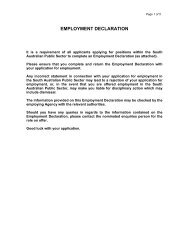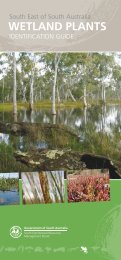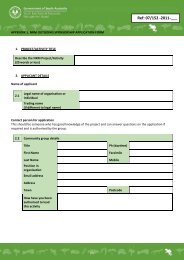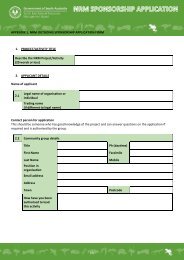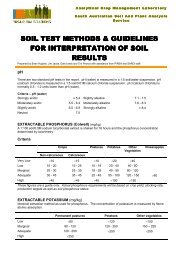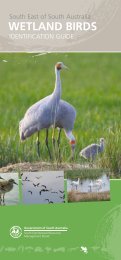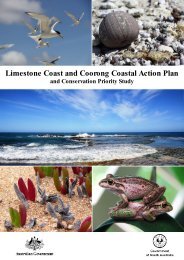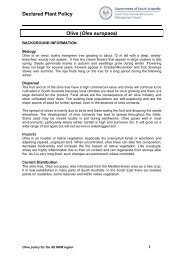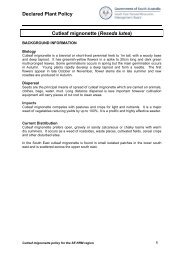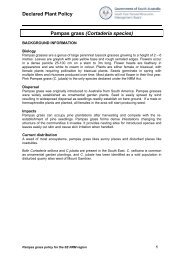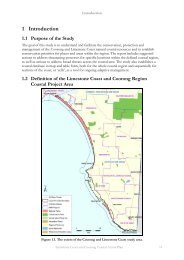Cell Descriptions - South East Natural Resources Management Board
Cell Descriptions - South East Natural Resources Management Board
Cell Descriptions - South East Natural Resources Management Board
You also want an ePaper? Increase the reach of your titles
YUMPU automatically turns print PDFs into web optimized ePapers that Google loves.
SE11 – Guichen Bay<br />
Tiny areas of wetland, such as McInnes Swamp, trapped behind the dune ridge barrier, and<br />
around small lakes near the mouth of drain L, are high value exceptions to this pattern. Here<br />
habitat for the focal species Swamp Skink, <strong>South</strong>ern Bell Frog and Yellowish Sedge-skipper,<br />
together with a moderate overall wetland value score, raises the total.<br />
Threat Analysis (GIS)<br />
Guichen Bay has the highest total of threat summary means in the region, 74.69. High threat<br />
values are distributed throughout the cell, with no part having medium or low totals.<br />
Development zoning is a high average as primary industry zoning is extensive; private land<br />
ownership is extensive with the exception of the foredune which is unallotted Crown land or<br />
park; many residential dwellings within the Guichen Bay dune ridges raise the total for existing<br />
development; land use and mining; significant weeds are widely distributed through the partially<br />
cleared dunes; numbers of feral animals and dune instability, all make significant contribution to<br />
this total.<br />
Adaptation to Climate Change: Threats for cell SE11<br />
(see also discussion of scenario in Section 4.11<br />
NOTE: the advice below is indicative of likely change and the direction of change, with<br />
implications for ecosystems. Dates, amounts and probabilities cannot be accurately calculated at<br />
this time. Thus advice on flood levels, for example, should not be used in engineering or<br />
development planning.<br />
Climate change<br />
element/ scenario<br />
Combined climate<br />
changes and sea<br />
level rise<br />
throughout this<br />
cell<br />
Sea level rise:<br />
2030 : +c.20cm<br />
2070: +c.80cm.<br />
Storms:<br />
Frequency continues<br />
to show great<br />
variation on a<br />
Impacts and implications Protect and manage Address landscape<br />
(for this cell) habitat threats issues: fire,<br />
connectivity,<br />
refuges, hydrology<br />
This cell presents a complex<br />
pattern of habitats sensitive to<br />
change.<br />
Increase in beach recession,<br />
storm foredune damage and<br />
dune instability. Loss of small<br />
cliff-backed pocket beaches at<br />
the northern and southern<br />
ends of the bay.<br />
Acceleration of calcarenite cliff<br />
erosion.<br />
Foredune damage could lead<br />
to widespread dune destabilisation<br />
and transport of<br />
sand across dunes to the lakes<br />
and farmland.<br />
2030: Occasional storm tide<br />
flooding above highest known<br />
tides. Lidar data suggests that<br />
marine incursion will ingress to<br />
Create a baseline for<br />
shoreline, dune and<br />
lake change by<br />
establishing a rectified<br />
aerial photographic<br />
record at an<br />
appropriate resolution.<br />
Maintain an aerial<br />
photographic record<br />
of change.<br />
Create buffer zone to<br />
allow dune retreat<br />
where feasible.<br />
Continue to monitor<br />
recession and address<br />
hazards as required.<br />
Active management of<br />
dune blowouts.<br />
Manage sill on drain L<br />
tidal inlet to adjust to<br />
higher marine storm<br />
elevations as part of<br />
The creation of<br />
buffer zones to<br />
allow retreat of tide<br />
dependant<br />
ecosystems a<br />
regional issue with<br />
local implications.<br />
Limestone Coast and Coorong Coastal Action Plan 404



